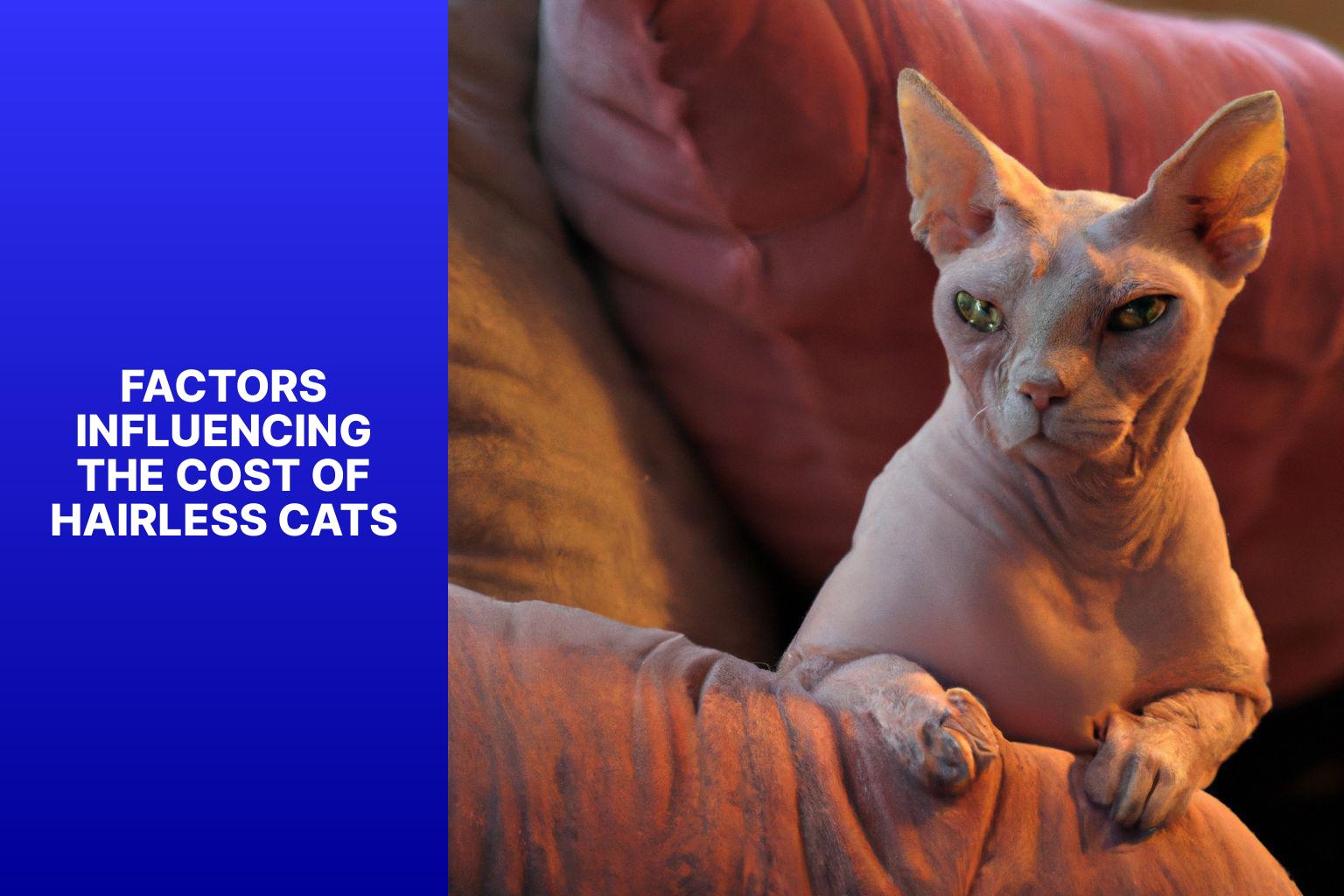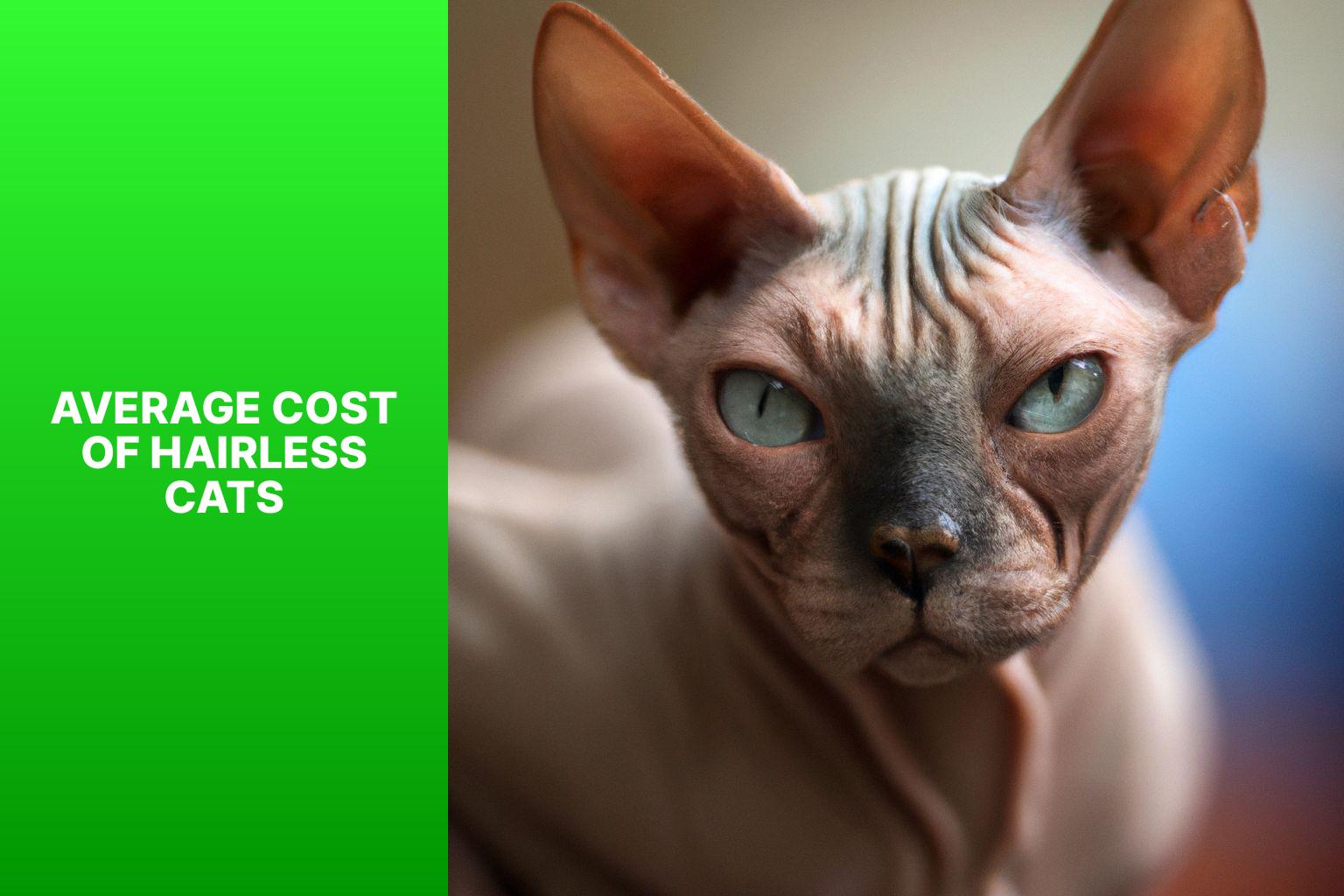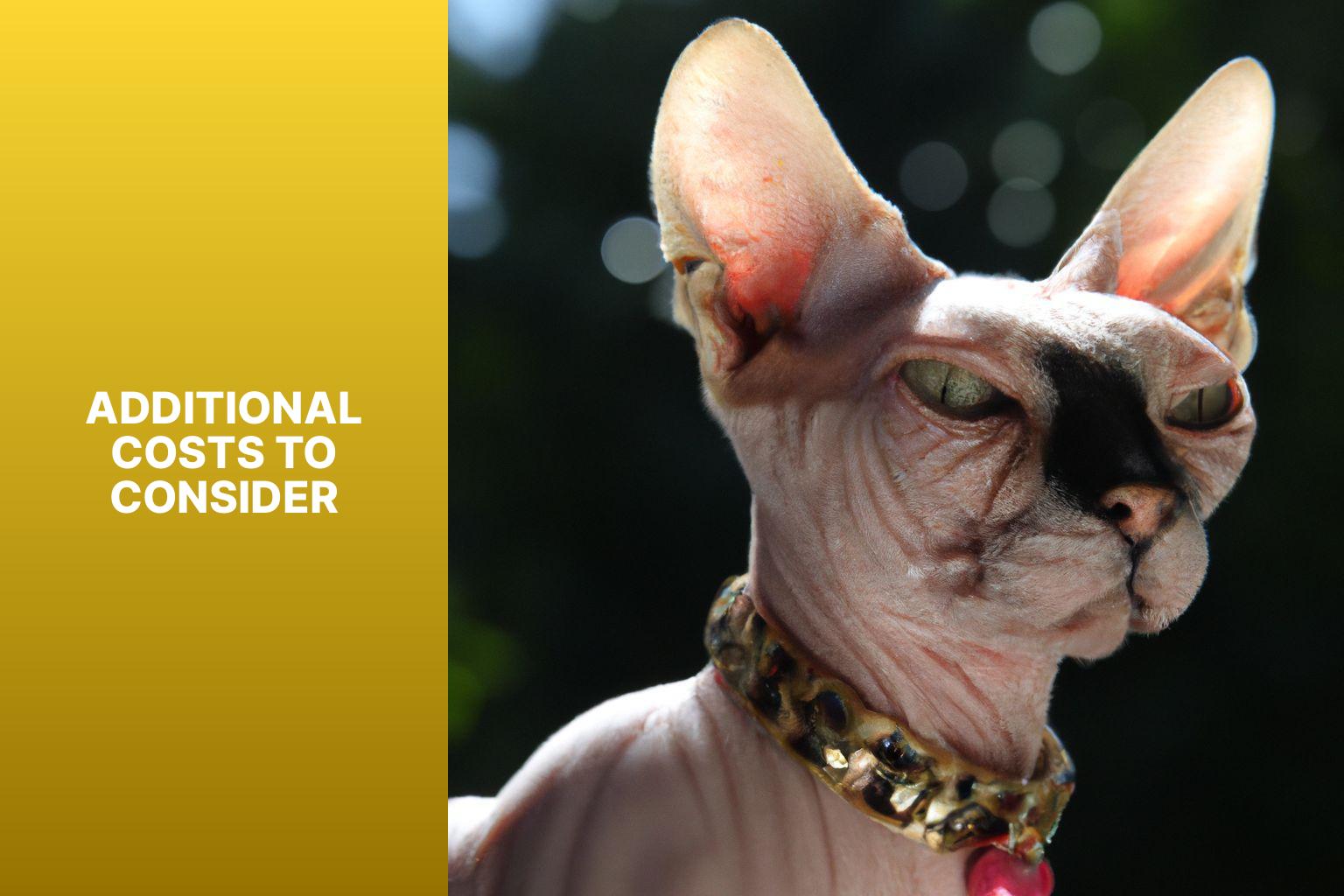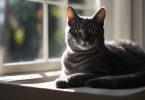Hairless cats, such as the popular Sphynx breed, are unique and captivating pets. Prospective owners often wonder about the cost associated with these unique feline companions. Several factors influence the price of hairless cats, and it’s essential to consider them when making a decision.
According to reputable cat breeders and pet resources, the main factors impacting the cost of hairless cats include the breed, quality, age, gender, and location. Each breed of hairless cat may have a different average cost, as there are varying demands and considerations associated with their breeding and supply. For example, Sphynx cats, Elf cats, Bambino cats, and Peterbald cats all have distinctive characteristics and price ranges.
It’s also crucial to take into account the additional costs that come along with owning a hairless cat, such as veterinary expenses, grooming supplies, specialized diet, neutering/spaying, and accessories.
To ensure a quality and healthy hairless cat, it’s important to find a reputable breeder who prioritizes the well-being of their cats. Considering these factors will help potential hairless cat owners make an informed decision and understand the investment required to provide a loving and suitable home for their unique feline companion.
Key takeaway:
- Certain factors influence the cost of hairless cats: The breed, quality, age, gender, and location all play a role in determining the price of a hairless cat.
- Different breeds have varying average costs: Sphynx cats, Elf cats, Bambino cats, and Peterbald cats have different price ranges based on their breed characteristics.
- Additional costs to be considered: Veterinary expenses, grooming supplies, specialized diet, neutering/spaying, and accessories/enrichment all contribute to the overall cost of owning a hairless cat.
Factors Influencing the Cost of Hairless Cats
Photo Credits: Www.Catcornerblog.Com by Gabriel White
When it comes to the cost of hairless cats, various factors come into play. These factors determine the price you can expect to pay for these unique feline companions. In this section, we’ll dive into the key influences on the cost of hairless cats. From the breed and quality to the age, gender, and location, we’ll uncover the different elements that contribute to the pricing of these captivating, hairless wonders. So let’s unravel the mysteries and bring clarity to the world of hairless cat costs.
Breed
The cost of hairless cats varies based on breed. There are four main breeds: Sphynx, Elf, Bambino, and Peterbald cats. Each breed has unique characteristics. Sphynx cats lack fur and have wrinkled skin. Elf cats have curled ears and hairless bodies. Bambino cats have short legs and a small stature. Peterbald cats have a sleek and slender appearance.
The cost of hairless cats also varies within each breed. Prices can range from a few hundred to several thousand dollars, depending on lineage, genetics, and show quality. Research reputable breeders and inquire about the cat’s lineage and characteristics.
Other factors such as age, gender, and location may also impact the cost of hairless cats. Older cats or cats of a specific gender may be priced differently. The location of purchase can also influence the cost, as availability and demand vary by region.
When looking for a hairless cat, consider the breed that best suits your preferences and lifestyle. Research thoroughly, ask questions, and ensure the breed aligns with your expectations. Considering these factors will help you make an informed decision and find the perfect hairless cat for you.
Quality
The quality of hairless cats can vary based on breed, lineage, and adherence to breed standards. Consider the quality of a hairless cat before purchasing to ensure a healthy and well-bred cat.
| Factor | Description |
|---|---|
| Breed | Different hairless cat breeds (Sphynx, Elf, Bambino, and Peterbald) have varying breed standards and characteristics. Each breed may have specific qualities that contribute to its overall quality. |
| Lineage | A hairless cat’s lineage can significantly impact its quality. Cats from champion lines often exhibit superior conformation, health, and temperament compared to cats without a proven pedigree. |
| Show Quality | Show quality hairless cats are bred to meet strict breed standards and are suitable for participation in cat shows. They possess desirable physical attributes and conform to breed-specific criteria. |
When considering the quality of a hairless cat, research reputable breeders who prioritize breeding healthy, well-socialized, and true-to-breed type cats. Be cautious of breeders with poor reputations or those associated with kitten mills, as they may not prioritize the quality and well-being of their cats.
Age
The cost of hairless cats varies based on age. Here is a breakdown of how age affects the cost of hairless cats:
| Age | Cost Range |
|---|---|
| 0-6 months | $1,500-$2,500 |
| 6 months – 1 year | $1,200-$2,000 |
| 1-2 years | $900-$1,500 |
| 2-3 years | $800-$1,200 |
| 3 years and above | $700-$1,000 |
As hairless cats age, their cost decreases. This is because younger cats have higher demand due to their cuteness and playful nature. Older cats may have a harder time finding homes, resulting in lower prices. These prices are approximate and can vary depending on breed, quality, location, and other factors.
When considering the age of a hairless cat, it is essential to consider your preferences and the cat’s needs. Younger cats may require more attention and training, while older cats may be more settled and independent. Older cats may already be spayed or neutered, saving you the additional cost and responsibility.
Ultimately, the choice of age should align with your lifestyle and the type of companion you are looking for. Whether you choose a kitten or an older cat, providing a loving and caring home is what matters most.
Gender
The gender of a hairless cat can affect its price. Male hairless cats are priced between $1500 – $3000, while female hairless cats have a slightly higher price range of $2000 to $3500. This pricing difference is influenced by breeding demand and potential breeding capabilities.
Note that these prices are average and can vary based on breed, quality, location, and breeder reputation.
If you are considering buying a hairless cat, research and compare prices and characteristics from reputable breeders to find the right cat for your needs and budget.
Fun Fact: Hairless cats, like the Sphynx breed, are known for being affectionate and playful, making them popular among cat enthusiasts.
Location
The location where you purchase a hairless cat can affect the cost. Prices can vary depending on the breeder’s location and demand for hairless cats in that area. More breeders in certain locations can lead to more competition and lower prices. Conversely, fewer breeders in a specific location can result in higher prices due to limited availability.
When considering the location, factor in additional costs like transportation expenses. If you find a reputable breeder in a different location, consider the cost of traveling or shipping the cat to you. These additional costs can increase the overall price.
| Breeder’s Location | Price Range |
|---|---|
| Local breeders | $1,500 – $3,000 |
| Out-of-state breeders | $2,500 – $5,000+ |
Note that while location can influence the cost, it should not be the sole factor in your decision. It is crucial to find a reputable breeder who prioritizes the health and well-being of their cats. Responsible breeders have a good reputation, provide proper documentation, and ensure their cats are well-socialized and cared for. Avoid supporting kitten mills, as they often engage in inhumane practices and can result in health issues for the cats.
Average Cost of Hairless Cats
Photo Credits: Www.Catcornerblog.Com by Dennis Nelson
Looking to bring home a hairless feline companion? Let’s talk about the average cost of hairless cats. From Sphynx to Elf, Bambino to Peterbald, each sub-section of this article will shine a light on the price range you can expect for these unique and captivating breeds. Get ready to dive into the world of hairless cats and discover the financial considerations that come with these extraordinary feline friends!
Sphynx Cats
Sphynx cats are a popular breed of hairless cats known for their unique and distinctive appearance. When considering purchasing a Sphynx cat, there are key factors to keep in mind.
Sphynx cat costs can vary depending on factors such as the breeder and specific qualities of the cat. The price range for a Sphynx cat is typically $1500 to $4000.
Consider the breed quality. Sphynx cats from champion lines or show quality cats are often priced higher due to their lineage and potential for success in cat shows.
The age and gender of the cat may impact the cost. Kittens are generally priced higher than adults, and female cats may be priced higher than males due to their breeding potential.
Last, the location of the breeder can influence the cost. Breeders in high-demand areas or regions with limited availability may charge a premium for their Sphynx cats.
When looking to purchase a Sphynx cat, thoroughly research and find a reputable breeder who prioritizes the well-being and health of their cats. Avoid supporting kitten mills and ensure that the breeder has a good reputation within the cat community.
By considering these factors and finding a reputable breeder, you can find a Sphynx cat that fits your preferences and provide it with a loving home.
Elf Cats
Elf cats, also known for their hairless bodies and distinctive appearance, are a unique breed.
The cost of Elf cats can vary depending on various factors such as breed availability, breed quality, age, gender, and location.
It is common for rarer breeds or those bred from champion lines or show quality parents to be more expensive.
Younger kittens typically come with higher price tags compared to older cats.
The prices of male and female Elf cats can differ.
The cost of an Elf cat may vary depending on the region or country where it is purchased.
When considering the cost of an Elf cat, it is essential to consider the additional expenses associated with cat ownership.
These expenses include veterinary expenses, grooming supplies, a specialized diet, neutering/spaying, and accessories to ensure their overall well-being.
Bambino Cats
– Breed: Bambino Cats, a unique hairless breed resulting from a cross between Sphynx and Munchkin cats, are known for their short legs and lack of fur.
– Appearance: With their short legs and absence of fur, Bambino Cats display a variety of colors and patterns.
– Temperament: Friendly and affectionate, Bambino Cats thoroughly enjoy human companionship and engage in playful activities.
– Care: Due to their sensitive skin, Bambino Cats require special attention including regular bathing and ensuring warmth in cold climates.
– Health: Bambino Cats are generally in good health, although they may encounter specific health issues. It is crucial to select a reputable breeder who conducts health screenings.
– Price: Ranging from $1,500 to $3,500, the cost of a Bambino Cat is determined by factors such as lineage, quality, and the breeder’s reputation.
Peterbald Cats
Peterbald Cats are hairless cats that originated in Russia. They have an elegant appearance and a playful personality. The cost of Peterbald Cats can vary based on their breed, quality, age, gender, and location.
Peterbald Cats are a rare breed and can be more expensive compared to other hairless cat breeds like Sphynx and Elf cats. Cats from champion lines or with show quality markings may be pricier. Kittens are usually more expensive than adult cats, and female cats may also have a higher price tag, especially if they are of breeding quality.
The cost may also vary depending on the breeder’s location and the demand for the breed. When buying a Peterbald Cat, consider these factors to find a reputable breeder and ensure a healthy pet.
Additional Costs to Consider
Photo Credits: Www.Catcornerblog.Com by Raymond Hill
When it comes to owning a hairless cat, there’s more to consider than just the initial cost. In this section, we’ll dive into the additional expenses you should keep in mind. From veterinary expenses to specialized diets and grooming supplies, we’ll uncover the various aspects that might impact your budget. Plus, we’ll explore the costs associated with neutering or spaying your cat and the accessories and enrichment items that can enhance their well-being. Let’s break down the numbers and discover the full picture of owning a hairless cat!
Veterinary Expenses
Veterinary expenses, such as regular check-ups and vaccinations, are crucial when owning a hairless cat. It is important to consider the following costs:
- Vet bills: Regular check-ups and vaccinations cost between $50 to $100 per visit.
- Health certificates: If you plan to travel with your cat, you may need health certificates which cost around $50.
- Health issues: Hairless cats may have skin allergies or respiratory problems. Treatment costs vary based on severity and required medication.
Budgeting for these veterinary expenses is crucial for your cat’s overall well-being. Regular vet visits and proper medical care ensure that your feline companion stays healthy and happy.
Grooming Supplies
When grooming hairless cats, consider their unique needs. Here are essential grooming supplies for hairless cats:
- Specialized shampoos: Use gentle shampoos specifically formulated for hairless cats to keep their skin moisturized and free from irritations.
- Lotion or moisturizer: Apply safe products designed to hydrate the skin effectively and prevent dryness.
- Nail clippers: Trim their nails regularly with cat-specific nail clippers to prevent discomfort.
- Toothbrush and toothpaste: Brush their teeth regularly with cat-specific toothbrush and toothpaste to maintain dental health and fresh breath.
- Eye and ear wipes: Use gentle wipes made for cats to keep their eyes and ears clean and prevent infections.
- Gentle brush or mitt: Brush hairless cats with a soft brush or grooming mitt to stimulate blood circulation and remove dead skin cells.
Remember to introduce grooming gradually and make it a positive experience for your hairless cat. Start with short sessions and reward them with treats or praise. Regular grooming will help keep your hairless cat healthy and comfortable.
Specialized Diet
When feeding hairless cats, it is important to provide them with a specialized diet that meets their unique nutritional needs. One should consider several factors when choosing the right food:
– Quality of food: It is crucial to select high-quality cat food specifically formulated for hairless cats. Look for brands that offer a balanced blend of protein, fat, and carbohydrates to support their overall health.
– Nutritional requirements: Hairless cats have higher energy requirements compared to their furry counterparts. Therefore, their diet should be rich in essential nutrients, including fatty acids. This will help maintain their skin health and regulate their body temperature effectively.
– Hydration: Hairless cats are prone to dry skin, so it is essential to ensure they stay hydrated. Consider incorporating wet food into their diet or provide fresh water at all times.
– Sensitivity: Hairless cats may have more sensitive stomachs, so it is crucial to monitor their digestion. If necessary, opt for grain-free or limited ingredient diets to address any sensitivities or allergies they may have.
– Vitamins and supplements: To support your hairless cat’s immune system and overall well-being, it is advisable to consult a veterinarian. They can determine if your cat requires any additional vitamins or supplements.
In my personal experience, I once had a hairless cat named Luna. Switching her to a specialized diet for hairless cats had a significant positive impact on her skin. It made her coat softer and shinier, improving her overall health and appearance.
Neutering/Spaying
Neutering/Spaying is crucial when owning a hairless cat. Here are some factors to consider:
– Benefits: Neutering/Spaying your hairless cat plays a vital role in preventing unwanted pregnancies, reducing the risk of reproductive-related diseases, and eliminating behavioral issues caused by hormones.
– Cost: The cost of neutering/spaying can vary based on factors such as location, veterinarian, and gender. On average, it ranges from $50 to $200.
– Timing: It is recommended to neuter/spay hairless cats at around 5-6 months of age to avoid mating or reproduction issues.
– Health benefits: Neutering/Spaying improves your cat’s overall health and helps prevent certain cancers, infections, and behavioral problems.
– Responsibility: As a responsible cat owner, considering neutering/spaying is important for controlling the cat population and ensuring your cat’s welfare.
Take these factors into consideration and consult with your veterinarian to make an informed decision about neutering/spaying your hairless cat.
Accessories and Enrichment
Hairless cats benefit from certain accessories and enrichment items that improve their well-being and quality of life. Here are some important items to consider:
- Cat Supplies: Ensure you have all the necessary supplies for your hairless cat, including a litter box, scratching posts, and toys.
- Bedding: Provide your cat with comfortable bedding to keep them warm and cozy, as hairless cats are more sensitive to temperature changes.
- Food and Water Bowls: Choose suitable bowls for hairless cats, such as stainless steel ones that are easy to clean and bacteria-resistant.
- Clothing: Hairless cats can benefit from wearing clothes to protect their sensitive skin from the sun, cold weather, or potential scratches.
- Cat Trees: Hairless cats enjoy climbing and exploring. Investing in a cat tree or multi-level scratching post can provide them with exercise and entertainment.
Pro-tip: Regularly check your hairless cat’s skin for irritations or dryness. Consider using pet-safe moisturizers or oils recommended by your veterinarian to maintain their skin’s health and hydration.
Tips for Finding a Reputable Breeder
Tips for Finding a Reputable Breeder
When searching for a reputable breeder to buy a hairless cat, consider the following tips:
1. Research: Thoroughly research reputable breeders in your area. Look for breeders with a good reputation and positive reviews from past customers.
2. Visit the Breeder: Schedule a visit to the breeder’s facility or home to see their breeding environment. Check that the cats are well-cared for and living in clean and healthy conditions.
3. Ask for Documentation: Request to see registration papers, health certificates, and genetic testing results for the cats. This will help verify the breeder’s commitment to breeding healthy and well-qualified cats.
4. Meet the Cats: Interact with the cats and observe their behavior. A reputable breeder ensures their cats have good temperaments and are well-socialized.
5. Ask Questions: Inquire about the breeder’s experience, breeding practices, and the care they provide to their cats. A responsible breeder will be knowledgeable and transparent in their answers.
6. Contract and Health Guarantee: Obtain a written contract outlining the sale terms and any health guarantees provided by the breeder. Make sure you understand your responsibilities and what the breeder will provide in case of health issues.
By following these tips, you can increase the likelihood of buying a healthy and well-cared-for hairless cat.
Some Facts About How Much Does a Hairless Cat Cost:
- ✅ The cost range for a hairless cat, specifically a Sphynx kitten, is $2,000 to $10,000. (Source: Our Team)
- ✅ Hairless cats from champion lines or with unique colors may exceed the typical price range. (Source: Our Team)
- ✅ Kitten mills, which prioritize quantity over quality, may offer hairless cats at lower prices but may not provide proper care. (Source: Our Team)
- ✅ True breeders registered with a cat association and offering personalized care provide more valuable hairless cats. (Source: Our Team)
- ✅ Factors such as health testing, veterinary visits, and lineage also influence the purchase price of a hairless cat. (Source: Our Team)








